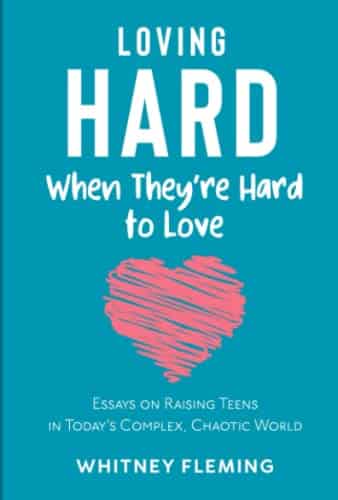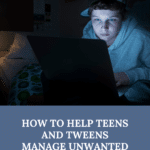
When my daughter was 10-years-old, she came across a pornography site while shopping for a Halloween costume with her two cousins. At the time, I didn’t think she knew enough about computers to shop online by herself, so, underestimating her ability meant she was alone in navigating that moment.
When this group of three tween girls saw the sexually explicit images that day, they knew them to be “inappropriate” and left the site, but not before a small bit of innocence was robbed.
My daughter later said, “I couldn’t erase what I saw, or rewind the tape on that experience.”
Her “experience” represents a challenge so many teens and tweens face today.
The pandemic made managing sexual cyber content even more challenging for parents.
A study published in the Journal of Adolescent Health pre-pandemic reported that one in five youths were seeing unwanted sexual material online—and one in nine are getting unwanted requests for sexual content from their peers or adults. Many online safety experts are hypothesizing that this number has significantly increased in the last few years.
Why is this happening?
First, pornography sites are incredibly profitable, which means sexually-explicit and porn-based businesses are popping up every day. According to global website traffic data from Statista, the top 3 porn sites in the world receive a combined 5.81 billion website visits per month. Even when parents use all sorts of resources to block these types of sites, due to the slippery nature of media advertising and the cunning ability of sex marketers, it is next to impossible to make the Internet a “safe place.”
Second, screen time increased significantly during the pandemic, so there were more opportunities for adolescents to come across sexual content. According to a Common Sense Media report looking at screen time of tweens and teens during the pandemic year 2021, on average 8- to 12-year-olds use about five and a half hours of screen media per day (5:33), while 13- to 18-year-olds use about eight and a half hours of screen media (8:39), a much faster increase than the previous four years. Social media use grew to 38% among 8-12-year-olds, and teens reported using social media for nearly one and a half hours every single day. Interestingly, both age groups reported that watching videos on YouTube was their favorite activity.
Lastly, coupled with the increase in screen time, according to Digital Trends.com, cyber harassment and bullying among teenagers rose 70% in the months following Covid lockdown, including issues like sexting and distribution of explicit materials and videos.
Parents need to do more than monitor–they need to teach their kids how to manage this behavior on their own.
No one tells you when you become a parent that some of the biggest emotional challenges will involve the statements and behaviors of people outside the family and who you as a parent may never meet. But the online relationships that teens and tweens navigate every day are exponentially more complex, hard to monitor, and downright frightening.
There are several ways your tweens and teens can come across unwanted sexual content. In the case of my daughter, it was inadvertently coming across a pornography site because she clicked on the wrong image. Other ways include unwanted naked images sent via text or social media message, online solicitation from strangers in chats, pop-up ads during an Internet search, or images distributed via mass spam emails. Social media platforms are breeding grounds for sexual predators, and most do not even do the minimum of protecting young people from exposure.
As we move to the end of the pandemic and kids return to a more normal life experience, parents are struggling to find an effective response. Even if you never allow your child near a computer or smartphone, chances are they could still see inappropriate content on someone else’s device, so we need to teach them how to manage these behaviors.
It’s also important to stress that some tweens and teens do seek out pornography on the Internet. According to the Family and Youth Institute, 32 percent of boys and 23 percent of girls under the age of 18 have spent more than 30 minutes looking at online porn on at least one occasion. Most search it out because they want to learn more about sex and the feelings they are experiencing, which underscores the need to continuing to talk to our tweens and teens about these issues.
It is never too late to help your tweens and teens set online boundaries and teach them about Internet safety.
Helping teens and tweens manage this cyber tsunami that has taken place since the pandemic requires layers of discussion, none of which can happen all at once. Engaging with kids in casual-style conversations (especially in non-invasive environments like riding in the car) that are short in duration, helps them integrate the content without getting overwhelmed or (worse) shutting down.
Parents are wise to have these conversations at younger ages, like before a child gets their first smartphone, and continuing them through to college. Communication should be progressive since each year there are different levels of exposure and changes to development, meaning that parents have new opportunities for discussion about personal boundaries and safety.
No adult can monitor what teens and tweens are exposed to all the time. Instead, we should teach our kids how to monitor and manage it for themselves As uncomfortable as it may be at first, it’s crucial we have conversations with our kids about the types of images they will likely come across on their screens.
How to Talk to Your Tweens and Teens about Unwanted Sexual Content and Mitigate Online Exposure
In our Be Strong, Be Wise Sexual Safety Education course for teens, we talk a lot about cyber safety. One of my students was only thirteen when she told me that requests for nude pictures were a weekly part of her school experience, as well as her friends’ experience.
No matter how often I hear an account like this in one of my classes, which is often, my heart sinks every time. At thirteen, this young person had little, if any, experience as a sexual being, and yet was being forced to see herself that way. Navigating ongoing sexual harassment, of which requests for nude pictures are just an example, has become so common that some teens have described the experience as a “normal” part of both middle school and high school.
When asked what she and her friends do in response to these requests, she said, “We just block them and ignore it.”
Like my young student, most teens would rather “ignore it” than consider reporting to an adult. No one wants to be a “snitch” among their peers, especially when so many of their friends are receiving the same illicit material. So how can parents of teens and tweens protect their children when they don’t always know what they are protecting them from?
Here are a few basic questions to ask your teen or tween about managing their online presence. Of course, being able to discuss these issues means you have been talking to your kids about sex previously. We get it, talking about sex with your tween or teen is hard, but remember, it’s never too late to start.
- How old were you/do you remember when you were first exposed to explicit sexual content online?
- How has that unwanted exposure, or anything you’ve witnessed since, affected your understanding of sex and relationships?
- What do you think about the fact that studies show pornography use has “ruined” the ability for healthy relationships, according to many college-age men?
- What do you/would you say to a peer or classmate who sends you inappropriate texts or images?
- What does it feel like when you see something on your screen that you know is wrong or hurts someone else?
- Do you know the legal consequences of sexting when you are a minor?
While boys are more likely to view porn, many young girls are often the first to send inappropriate photos via text or social media. Boys receive inappropriate requests too and studies show that both boys and girls are being influenced by pornography at younger and younger ages. This is why we need to have frank discussions about online pornography and the impact it has on their mental health and well-being. If we can help them understand porn’s impact on their behavior, we could reduce inappropriate behavior and other online risks.
In her book, Boys and Sex, Peggy Orenstein interviewed dozens of young males ranging from middle school to college-aged. What she found was that boys openly admitted that pornography had effectively “ruined” their ability to create and sustain healthy relationships with women. And yet, in interviews with both boys and girls, and gender-other teens, Orenstein found that “trust and connection” were the things young people desired in a romantic relationship, above all else.
When something is seen as “normal”, we stop trying to do anything to fix it. Helping teens and tweens understand the law as it applies to cyber harassment and bullying, supports them in taking the right action, should they need to. It also increases the likelihood of healthy romantic connections based on trust and respect.
What to do if your child is the victim of sexual cyberbullying, online harassment, or unwanted sexual content.
If your child experiences cyberbullying or sexual harassment, here are a few pieces of legal advice from the Cyber Civil Rights Initiative:
- If you’re aware that photos of you are being broadcast online, take screenshots of the posts and relevant internet search results for your name.
- Record URLs and messages. Save this information on your computer, but also print out a copy to take to the police.
- Remember that cyber harassment (including sharing naked pictures online) is against the law and can lead to jail time, as well as significantly harm chances of future employment, college admissions or military service/law enforcement. These groups often check social media and online before committing to hire or admit someone.
We also suggest the following:
- If you have Apple devices and Family Sharing in place, you can turn on alerts in your child’s Messages app that provide a warning before sending or receiving sexually explicit material.
- For inexperienced smartphone users, consider setting up a monitoring service such as Bark, which provides parents with an immediate warning if their child’s device is being used for inappropriate content. We suggest to parents that they disclose that they have put the monitoring system on the phone to develop an atmosphere of trust–and also let your child know that keeping the software running is part of the agreement to them keeping the phone.
- Let your teen or tween know that you’ll be checking their online activity at irregular intervals. This is for their own safety, and parents have more than enough information about cyber risk to warrant spot checks.
- Consider setting up household rules about sexting. As with any harmful activity, there can be consequences in place that teens and tweens know about in advance. We suggest having your child sign a cell phone contract to take any arguing out of the equation.
- Have ongoing conversations about the motivation behind sexting, watching pornography, or any other inappropriate online behavior. Again, creating an atmosphere of trust means withholding strong judgment and starting with empathy. In other words, it’s normal for teens to want validation or information, but can they explore other means of getting it?
- Provide teens and tweens with necessary information about the risks of sexting, watching pornography, etc.. For example, people frequently pass along nudes without permission and sexual predators use nudes to threaten victims. When photos have spread online, as they often do, social media companies can take a long time to address the issue. Parents should know that Google has a tool that allows families to request that photos be removed from search engines’ image results.
- Finally, have ongoing conversations about consent. Just because a teen or tween receives a provocative image, doesn’t mean they have to reciprocate. Let your child know they can come to you if they ever feel pressured or pushed to engage in online activity outside their comfort zone.
Teens need, but more importantly want, boundaries, especially online.
The cyber tsunami of more screen time for kids has many parents worried about the effects on their children, but studies have shown that teens and tweens want more support for increased cyber safety. According to Dosomething.org, 83% of teens believe that teachers, politicians, and social media companies are not doing enough to address the issue.
There are not many tweens or teens who will say they want their parents to reduce or monitor their screentime, but that doesn’t mean we shouldn’t do it. Parents have a lot more influence than they think in tackling the problem early, and maintaining an ongoing conversation that allows children to put their safety first.
This is a contributed post by Amy Carpenter.
Amy Carpenter, LCSW, CYI, is a bestselling author, educator, and psychotherapist with over twenty-five years of experience. Her work has been featured on CBS, NBC, ABC, USA Today and hundreds of nationally-syndicated newspaper and magazine outlets. She is the founder of the Be Strong, Be Wise Sexual Safety program, and the author of two books in the bestselling Be Strong, Be Wise series.
Be Strong, Be Wise incorporates the safety “tools” that enhance personal and group awareness, supporting healthy relationships for young people from all walks of life. A long-time youth advocate, Amy believes every young person deserves to learn how to create healthy partnerships and avoid toxic ones. Her book series and programs explore sexual ethics in straightforward terms that build self-knowledge in young people and confidence in adults.
*If interested in the upcoming BSBW course for teens, starting May 9th, go to: https://www.bestrongbewise.com/programs-for-youth
Are you in the thick of raising your tweens and teens? You may like this book by Whitney Fleming, the co-owner of Parenting Teens & Tweens: Loving Hard When They’re Hard to Love: Essays about Raising Teens in Today’s Complex, Chaotic World.

* This post contains affiliate links where we earn a small commission for sales made from our website.







Leave a Comment